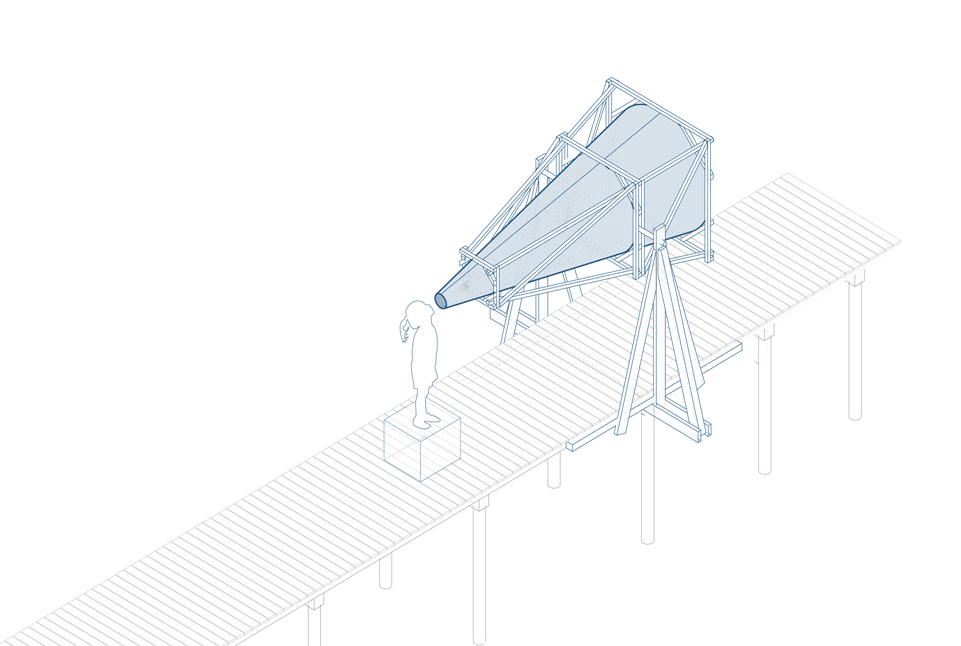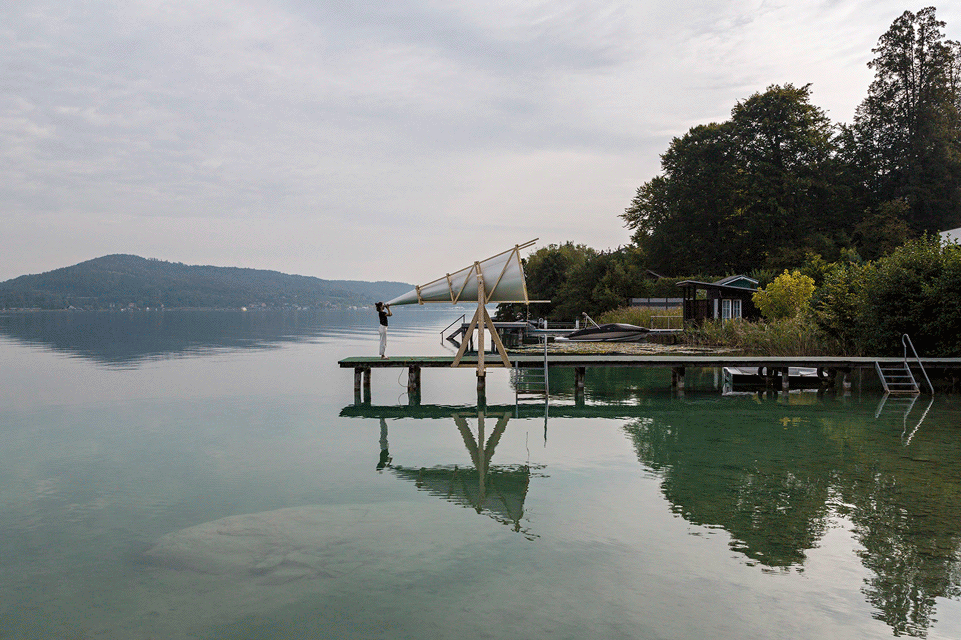查看完整案例


收藏

下载
奥地利 Wörthersee 湖岸有 83%是不可进入的区域,只有南岸的一处住宅用地有机会向公众打开,那便是维也纳童声合唱团的夏季宿舍。
在 2021 年,AA 建筑联盟学院的 nanotourism Visiting School 团队花费 2 周时间,在 Wörthersee 湖畔建造了 3 个相互关联的建筑干预项目(交流栅栏、凝视和声炮),以改善湖泊的过度私有化性质,同时在合唱团社区与当地公众之间建立文化交流的桥梁,使合唱团校园能够在未来成为一个全年活跃的文化场所。
▼项目概览,Preview© Paul Sebesta
Over two weeks, students design and build a series of three architectural interventions to address and critique the hyper-privatised nature of Austria’s Lake Wörthersee. Wörthersee has 83% of its shoreline inaccessible to the public. At the same time, located on the lake’s south shore, the Vienna Boys’ Choir Summer Residence is an underused property and one of the last remaining places with an opportunity to open up for the people.
The project critically addresses the lake’s wild privatisation and the current unawareness of the cultural presence of the Vienna Boys’ Choir in the local community. The three interconnected interventions: ‘Exchange Fence’, ‘Stare!’ and ‘Sound Cannon’, offer tools for a new cultural exchange between the Boys’ Choir community and the local general public, capable of addressing the future transformation of the Vienna Boys Choir Campus into an all-year-round cultural venue.
▼3 个相互关联的湖畔装置,Thethree interconnected interventions© Paul Sebesta
01. “交换栅栏”
好的栅栏带来好的邻居
Exchange Fence
Good Fences Make Good Neighbours
这是一个结合了栅栏和商店的装置,能够通过鼓励材料交换来调解公共边界。
合唱团宿舍的 6 英亩土地包含了大量的自然资源,并且得到了全年的精心呵护。可孩子们实际待在校园的时间只有短短两个月。场地的维护会定期产生一系列自然“废料”,例如干草、杂草、树皮和原木等,它们曾经在当地农业经济中具有特定的价值。
本次干预提出了一种不同类型的“深栅栏”,将原有的功能单一的围栏替换为一个立体结构,使其不仅作为屏障使用,还包含存储系统、商店和市场的功能,可以容纳并售卖校园在全年产生的天然废料。该结构旨在激发新的交换形式,并就季节性的维护日程、废料和该区域的土地私有化概念进行探讨。
Part fence, part store, ‘Exchange Fence’ mediates the public boundary by stimulating material exchanges.
The six-acre property of the Vienna Boys’ Choir is full of natural resources that are carefully being maintained and manicured throughout the four seasons of the year regardless of the short period of two months when the boys are actually at the Campus. The upkeeping of the estate is regularly producing a set of natural “waste” materials, from hay, grass, shrubs and bark to branches and logs, that used to contain specific values in the local farming economy.
In an approach to sustainably resolve land management issues, the intervention looks at the Campus’ residue material as a resource for stimulating neighbouring relationships through storage and trade of those materials.
Replacing the existing monofunctional and dividing fence and recognising its typology’s contextual, social and economic potential, the project proposes a different type: a ‘deep fence’. This three-dimensional structure still functions as a barrier to the site, which additionally operates as a storage system, storefront and marketplace of natural waste materials produced at the Campus throughout the year. The publicly accessible structure aims to stimulate new rituals of exchange and debate on seasonal maintenance routines, waste and the notion of privatisation of land in the region.
▼“交换栅栏”,‘Exchange Fence’© Paul Sebesta
▼一个结合了栅栏和商店功能的装置,Apart fence, part store installation© Paul Sebesta
▼细节,Details©AA nanotourism archive; © Paul Sebesta
02. “注视!”
原湖岸线的公共码头
Stare!
Public Pier of a Former Shoreline
“注视!”(Stare!)是一个微型观景台,提供望向湖面的私人化视野。由于湖岸分布着众多围栏式的私人住宅场地,合唱团校园所在的道路无法一眼望到湖面。为了应对这种将湖景私有化的局面,该项目提出修建一个可供公众使用的观景平台,使过往的游客可以从一处僻静的台阶上近距离欣赏湖景。平台同时也可以作为表演观众席使用,可以容纳 20 名观众参与校园码头上的表演。合唱团的成员们还可以在这里举办小型公共活动,从而增强学校与 Wörthersee 湖畔社区的联系。
The micro auditorium, ‘Stare!’ is a public space with a private view, inviting the audience to a new lake vista.
Vienna Boys’ Choir Campus is located halfway of the longest – 1.3 km long – stripe of the lake’s perimeter road that offers not a single glance to the lake. Reacting to the excess of fenced-off shoreside properties that privatise the lake view, the intervention provides several alternatives. Firstly, it proposes a publicly accessible viewing platform that enables passing visitors to enjoy the lake’s views from a secluded stairway by bringing the viewer closer to the water and away from the noisy road. Secondly, as an altered exemplar of the pier typology, the project testifies about the former shoreline of Lake Wörth, which was lost in 1770 after the artificial lowering of the lake’s water level. Therefore, the intervention is devoted to leisure, but it also educates visitors on almost forgotten past. Finally, it doubles as the auditorium that can host an audience of 20 people taking part in the performance happening on the existing campus’ pier. The pier and the wooden stair-like structure are axially aligned to work together as one, spatially correlating setting. Opening up the possibility of hosting a performance encourages the Vienna Boys’ Choir members to stage small public events to reinforce their singing identity and relation to the Wörthersee’s community.
▼“注视!”观景台,‘Stare!’, themicro auditorium© Paul Sebesta
▼平台也可作为观众席使用,‘Stare!’ proposes a publicly accessible viewing platform to enjoy the lake’s views or the performances© Paul Sebesta;© AA nanotourism archive
▼装置外观,Exterior view© Paul Sebesta
▼装置细节,Detailed view© Paul Sebesta
03. “声炮”
扩大当地文化之声
Sound Cannon
Amplifying the Local’s Culture Voice
“声炮”是 Wörthersee 湖岸地区独特声乐文化的“模拟放大器”。
凭借独特的声学和空间质量,Wörthersee 湖泊已经成为一处天然的声音发射器,在一天的不同时段提供了多种多样的声音体验。另一方面,维也纳童声合唱团以其美妙歌声闻名于国际,可湖边的社区大都并不知道他们的存在。
怀着为合唱团发声的愿景,项目团队将湖面设想为一个扩音装置,旨在将合唱团独一无二的歌声与精神传达给湖岸的社区。“声炮”被安装在既有的木制码头上,为合唱团、当地音乐家和公众提供了一个互动的焦点。可翻转的喇叭既可以朝向湖面,也可以朝向陆地,从而能够将声音同时传播给湖岸社区和码头上的观众。“声炮”成为了 Wörthersee 湖泊声景的一部分,同时也带来了更多进行音乐实验的机会。
▼“声炮”被安装在既有的木制码头上,The Sound Cannon is fixed on the existing wooden pier of the Campus© Paul Sebesta
▼“声炮”分析图,Sound Cannon – Diagram©AA nanotourism archive
Standing knee–deep in the lake and singing, ‘Sound Cannon’ is an analogue amplifier of the unique vocal culture of Wörthersee.
The lake is a shared space of the Wörthersee area inhabitants. With its acoustic and spatial qualities, it already functions as a natural sound transmitter, offering multiple experiences of sound travelling across the lake throughout different times of the day. On the other hand, Vienna Boys’ Choir is internationally well known for their singing, but the lake’s community is mostly unaware of their presence.
With the ambition of giving the voice to the Choir, the project imagines the lake as a sound facilitator that distributes the high cultural identity of the Vienna Boys’ Choir to the local community on the lake. Fixed on the existing wooden pier of the Campus, the Sound Cannon becomes an amplifier of the local music culture, providing an interaction point between the Vienna Boys’ Choir, local musicians and the public.
The horn is a kinetic, flipping device. It can either face the lake and distribute the sound to ‘accidental’ listeners of the lake’s community or face the land to perform to an audience on the Vienna Boys’ Choir publicly accessible plot. Used in new performative rituals, the Sound Cannon contributes to the soundscape of Wörthersee and allows for musical experimentation that is a long tradition of the lake’s history.
▼可翻转的喇叭,The horn is a kinetic, flipping device© Paul Sebesta
▼细节,Details
© Paul Sebesta
▼场地平面图
Lake Front Plan
©AA nanotourism archive
▼场地剖面图,Lake Front Section©AA nanotourism archive
project title:All Year Round Cultural Campus
location:Vienna Boys’ Choir Summer Residence, Sekirn on Wörthersee, Austria
school programme:AA nanotourism Visiting School, 2021
Architectural Association, School of Architecture, London, UK
time:31.8 – 15.9.2021
project mentors: Aljosa Dekleva, Programme Head
Thomas Randall-Page, Invited Mentor
Amanda Sperger, Programme Assistant
Jakob Travnik, Programme Assistant
Andreas Maximilian Arndt, invited Tutor
project participants:
Exchange Fence – Good Fences Make Good Neighbours:
Elias Bouyssy – France
Oliver Canins – Italy
Amanzholl Kellett – UK
Iva Grlić Radman – Croatia
Mihail Sugarev – Bulgaria
Stare! – Public Pier of a Former Shoreline:
Anna Bernbacher – Austria
Pia Fattor – Argentian
Kim Gubbini – Luxembourg
Kya Kerner – USA
Jeremias Pointner – Austria
Sound Cannon – Amplifying the Local’s Culture Voice:
Eleonora Balestra – Switzerland
Clara Copiglia – Switzerland
Kanto Ohara Maeda – Japan
Anne Steffen – Luxembourg
Mykhailo Zhuk – Ukraine
school’s programme visiting experts & critics:
Theo Deutinger – TD
Volker Dienst – Vienna Boys’ Choir, architektur in progress
Philipp Furtenbach – AO&
Tina Gregorič – dekleva gregoric architects, TUW
Astrid Meyer Hainisch – Hotel Ogriss am See
Elias Molitschnig – Green Party, Carinthia
Jakob Ottacher – Rubner Holzbau
Christopher Pierce – Architectural Association, London
Roland Sint – Wörthersee Tourism
Peter Zöch – Snøhetta, Innsbruck
photographs:Paul Sebesta
AA nanotourism archive
partners:
Vienna Boys’ Choir – Austria
architektur in progress – Austria
TU Vienna – Austria
sponsors:
Rubner Holzbau* – Austria
Wörthersee Tourismus – Austria
Baukulturjahr Kärnten 2021 – Austria
Velux – Austria
*Special thanks to Rubner Holzbau, who, in addition to financial support, have also generously sponsored wood and supported us with their team of experts for the construction of the projects.

































